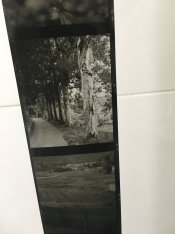So I have some updates from a bunch of experimenting today.
First, the failures to report:
I tried the exact same process with Fomapan R100 and got blank film after the bleach! I had run this in total darkness to see if I could get clearer highlights, so not by inspection as before. This outcome was a real surprise, but some experimenting afterward led me to some interesting outcomes. I thought it was the amount of time in the bleach so I reduced to 6 minutes, in a completely fresh batch of bleach, still in total darkness, and had the same result.
I then clipped off a 2cm section of R100, exposed it to a halogen light, and developed it in the first developer. I then took the blackened film and put it into the newest of the bleach batches in the light. Within about 30 seconds, it was heavily fizzing, something I had not seen before. I believe this is the silver-based anti-halation layer that is specific to R100.
I have a theory: that much bare silver is catalyzing the generation of peracetic acid and that in concentrated, localized amounts is able to eat the gelatin off the film.
That was all at 40C as before. I tried a section of Fomapan 400 in the same manner, in the same bleach. I got MUCH faster bleaching and a similar fizzing reaction after 30-40 seconds. That made me start to think.
Successes to report:
If what has happened is that there is a lot more peracetic acid than before, then maybe I could lower the temperature and try that. I cooled the bleach down to 22C (as much patience as I could manage), and then ran a 5 frames of pictures on Fomapan 400 through the first developer, wash, and bleach. This time I did the bleach by inspection. When I put the roll in, there was a lot of fizzing. I got concerned I'd end up with blank film again, but what the heck, it's an experiment. After about 2 minutes, the fizzing (you can hear it) pretty much went away and by inspection I could see that at 3 minutes, the film was fully bleached! At 22C. It appears that whatever reaction took place with the R100 has noticeably stiffened up the bleaching action. I finished the process on that roll of film and it's hanging to dry. A bit dark, but it was shot under tungsten light (it's getting dark here by 3:45pm) in my Electro 35 GSN which wouldn't have accounted for the slower film rating in tungsten light.
I then took another small clipping of Fomapan R100 and without developing it, put it into the bleach to see if the silver anti-halation layer would dissolve at 22C. It did. I only have this one roll of R100 that I can find (I swear I have more) so I will give it another shot when I've worked out more of the variables.
Follow ups:
- Does the bleach stay strenghtened? When I get it out next time, has the effect dissipated? (presume yes)
- Is it possible to bleach R100 at room temperature and not have it go apeshit?
- Does catalyzing the reaction on purpose at the start make sense? I am thinking a crappy silver spoon or similar.
- The right way to do this bleaching may be to test a film leader for the film you are going to develop by fully exposing, developing, and bleaching it. Then run the process for that length of time. At least until we've figured more out about how it works.












